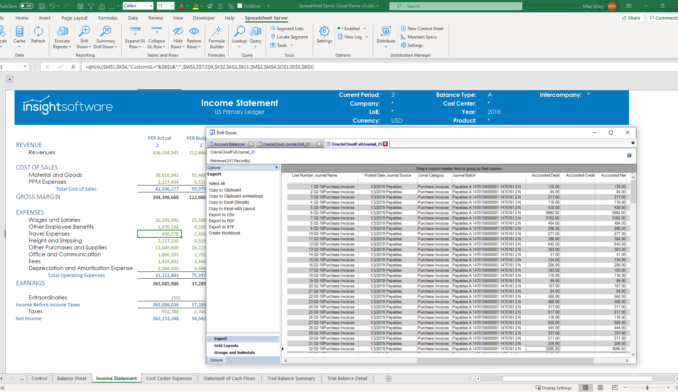CFO’s Guide to Financially Intelligent Cash Flow Management

Businesses around the world are facing an unprecedented level of uncertainty. In a recent panel discussion of CFOs hosted by insightsoftware, liquidity emerged as the number one priority for C-suite finance leaders.
As economic activity has slowed dramatically, many businesses report that sales have plummeted, collections have slowed, and cash flow has become increasingly difficult to predict. While government stimulus programs have promised some relief, most businesses are unlikely to see an influx of cash in the immediate future. Now more than ever, finance teams must monitor their business data in real time and be prepared to respond rapidly to change.
It is often said that cash flow is the lifeblood of every business. In good times, some businesses can afford to be somewhat less diligent in managing their cash flow. In today’s world, though, very few companies can afford that luxury. No matter how good your product is, if your business runs out of cash, it’s game over. Economic volatility has changed everything. Companies that bring a strategic view to cash flow analysis will be better equipped to weather this storm.
Cash Flow and Scenario Planning
According to Gary Michel, who serves on the Strategic Advisory Board for Genstar Capital, smart CFOs are currently investing a significant portion of their time in scenario planning, laying out best-case and worst-case scenarios that assist the rest of the C-suite in planning for the turbulent times ahead. Good cash flow planning is an essential element of that process.
The basic building blocks of a cash flow projection are simple. A/R collections and cash sales drive cash inflows. Outgoing payments to suppliers, payroll, and other expenses account for outflows. Investment in additional inventory or fixed assets can further drain cash, and non-operating cash flows (for example, from loan activity) round out the picture.
Most companies monitor some common metrics to make sure they are on track to maintain a sustainable level of cash into the foreseeable future. Days sales outstanding (DSO), for example, is a good proxy for cash inflows from customer sales. During disruptive times, however, both the numerator (outstanding receivables) and the denominator (credit sales) may fluctuate dramatically. A key metric that has been relatively stable over time may suddenly become volatile. Historically, low DSO has been an indicator of low bad debts expense, but in today’s environment, that might no longer be the case.
This is true of other metrics as well. Inventory turns, for example, may look reasonable from an annual perspective, but recent volatility may dictate a closer look at current inventory levels.
For the business as a whole, what is needed is a more discerning analysis of all the inputs and outputs to cash flow. That’s where having financial intelligence comes into play.
The Role of Financial Intelligence
Ordinary cash flow projections are built on an assumption that the world is a relatively stable place. In other words, we can expect that sales may rise a bit during the busy season and fall slightly in the off-season. Wild fluctuations are not typically a part of the picture.
In today’s world, though, everything has changed. Business leaders need to look deeper into the sources and uses of cash. They need to follow the chain of causation through several levels to get a better handle on what the future may hold.
To accomplish this, finance leaders need to think and act on a different level. We call this financial intelligence. Financial intelligence is a higher-order thought process about organizations and how they consume both internal and external information. At the heart of this new paradigm is the ability to bring together data from multiple systems and to make sense of that information in a way that creates value for the entire organization. Traditional business intelligence is tactical. Financial intelligence is strategic.
The financial intelligence paradigm is essential to operating in a volatile economy. Instead of just looking at credit sales for the current week or month, finance teams need to be looking at the sales pipeline. That means stepping out of the confines of the ERP system and gaining visibility to CRM pipeline data.
Business leaders need to better understand who their customers are and whether their creditworthiness may have changed due to recent events. That may require the company to collect data from external sources or to put measures in place to evaluate customers’ status periodically.
CFOs need to understand how their customers’ buying behavior is changing and how that may affect future cash flows. Is the company sitting on inventory that customers no longer want? For companies with an ecommerce storefront, changes in customers’ browsing behavior may offer some insights.
All of this implies a need for visibility to data that sits in disparate systems throughout the enterprise and even data that lives outside the enterprise. Tools that support financial intelligence connect to the various sources of data and bring it together in a way that can be used to produce positive business outcomes.
Real-Time Reporting Is Essential
When the situation is this volatile, business leaders need up-to-the-minute information, so finance teams need to track all of these numbers in real time. The ability to rapidly recognize threats and respond promptly may be the determining factor in the survival of many businesses in the coming year.
As credit tightens and banks are more carefully reviewing their loan portfolios, it will certainly be beneficial for businesses of all sizes to have a firm grasp on cash flow projections.
Companies may need to aggressively trim expenses, unload inventory, re‑allocate resources, or otherwise respond to external events. That necessitates a flexible, real-time reporting capability that finance teams can operate and modify without the involvement of outside consultants or experts from the IT department.
In today’s environment, cash flow planning is no longer a routine exercise intended to validate the solvency of an organization. It has become a strategic imperative, an essential element in the process of scenario planning for business continuity. CFOs who approach the task with a financial intelligence perspective will be well equipped to steer their organizations through the very rough waters ahead.







